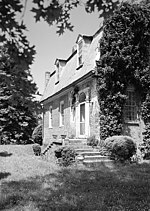James Owens Farm
Anne Arundel County, Maryland Registered Historic Place stubsGreek Revival houses in MarylandHouses completed in the 19th centuryHouses in Anne Arundel County, MarylandHouses on the National Register of Historic Places in Maryland ... and 2 more
Italianate architecture in MarylandNational Register of Historic Places in Anne Arundel County, Maryland
James Owens Farm is a historic home and farm at Bristol, Anne Arundel County, Maryland. The home was built by successful tobacco farmer James Owens and is a large mid-19th century, two-story brick cross-gable late Greek Revival/Italianate dwelling. Outbuildings are all of frame construction and include an early 19th-century cornhouse, an early 19th-century tobacco barn, a mid-19th-century board-and-batten kitchen, carriage house, and smokehouse, and a late 19th-century chicken house.It was listed on the National Register of Historic Places in 1987.
Excerpt from the Wikipedia article James Owens Farm (License: CC BY-SA 3.0, Authors).James Owens Farm
Geographical coordinates (GPS) Address Nearby Places Show on map
Geographical coordinates (GPS)
| Latitude | Longitude |
|---|---|
| N 38.803888888889 ° | E -76.660555555556 ° |
Address
20711
Maryland, United States
Open on Google Maps





